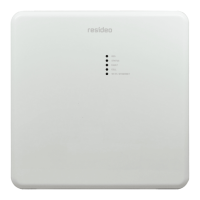
Do you have a question about the Honeywell Home LTEM-PV and is the answer not in the manual?
| Brand | Honeywell Home |
|---|---|
| Model | LTEM-PV |
| Category | Network Hardware |
| Language | English |
Overview of the LTEM-P Series Communicator and its capabilities.
Introduces the LTEM-P Series Communicators utilizing LTE CAT-M1 technology for IoT devices.
Explains how the LTEM-P communicates via Internet and cellular networks for alarm transmission.
Lists the basic features of the LTEM-P communicator, including connectivity and reporting capabilities.
Describes AlarmNet as a secure method for delivering alarm messages to a central station.
Details the communicator's supervision and fault detection capabilities, including communication failures and fault trigger outputs.
Explains Resideo's web-based services allowing remote access and notifications for security systems.
Outlines the two types of control panel connections: ECP and Bus connections.
Lists supported plug-in modules like LTE Communication, Wi-Fi/Z-Wave, and Dialer Capture modules.
Discusses the internal antenna and connection for an external antenna.
Emphasizes the requirement for weekly testing to ensure proper operation of the system.
Provides detailed technical specifications for the LTEM-P communicator, including dimensions, power, and environmental factors.
Details control panel compatibility and Compass version requirements for downloading.
Lists the standards the device has been tested against by ETL.
Provides essential notes and precautions for installing the communicator according to codes and best practices.
Guides the user on how to find a suitable mounting location by checking signal strength using the communicator's LEDs.
Describes the two mounting options: direct to a wall or to a VISTA control panel cabinet.
Provides step-by-step instructions for securely mounting the communicator to a wall.
Details the process for mounting the communicator onto a VISTA control panel cabinet.
Explains how to unmount and open the communicator after it has been installed in a cabinet.
Instructs on connecting the communicator to VISTA Series ECP control panels using different connection options.
Provides a table of maximum wire lengths for ECP and BUS connections based on wire gauge.
Guides on connecting the communicator to control panels that do not support ECP communication.
Details connections for specific DSC PowerSeries control panels.
Details connections for specific Interlogix NetworX (NX) Series control panels.
Explains how to wire the fault trigger output to a control panel zone for fail-safe mode.
Describes how to connect the communicator to the internet via Ethernet cable or Wi-Fi module.
Details how to connect the power adapter and backup battery to the communicator.
Provides information and instructions for installing and maintaining the backup battery.
Guides on installing optional modules like the LTE Communication Module.
Specific instructions for installing the PROLTE Series Communication plug-in module.
Details the installation and setup of the PROWIFIZW Wi-Fi/Z-Wave module for internet connectivity.
Step-by-step instructions for configuring the Wi-Fi connection using the AlarmNet 360 Mobile App.
Explains the functionality and installation of the optional Dialer Capture module (PRODCM).
Illustrates how to connect the Dialer Capture module to control panels and the phone line.
Provides further important notes and considerations when using the Dialer Capture module.
Describes when and how to install an external antenna for improved signal strength.
Step-by-step instructions for connecting an external antenna to the communicator.
Explains how the communicator delivers alarms via Internet or cell and the need for an AlarmNet 360 account.
Guides users on how to program the communicator via the AlarmNet 360 website or mobile app.
Lists programming options available in the AlarmNet 360 SETTINGS menu for the communicator.
Details the supervision settings, including daily supervision and its impact on communication failure notifications.
Covers communication path options (Ethernet/Cell, Wi-Fi/Cell, Cell Only) and related settings.
Explains the Fail-Safe mode option for the fault trigger output.
Configures which communication path failures will notify the control panel.
Details options for enabling Remote Access and Remote Control features.
Specifies the address for interactive event devices, often used with VISTA panels.
Lists factory-set options that cannot be programmed, like Cell Rollover and Power Save.
Explains ECP status codes displayed on the keypad when communication issues occur.
Guides on registering the communicator with AlarmNet to activate the account and enable reporting.
Provides a comprehensive summary of LED indicators and their meanings during various operations.
Lists Contact ID alarm and restore codes for various conditions reported by the communicator.
Defines technical terms and acronyms used throughout the manual.
Outlines FCC and ISED statements regarding equipment operation and potential interference.
Provides warnings and guidelines regarding RF exposure and antenna separation distances.
Advises that external cellular radio antennas must be installed by a professional installer.
Illustrates the wiring connections for the LTEM-P communicator to control panels and power.
Describes the functions associated with pressing and holding the Test switch.